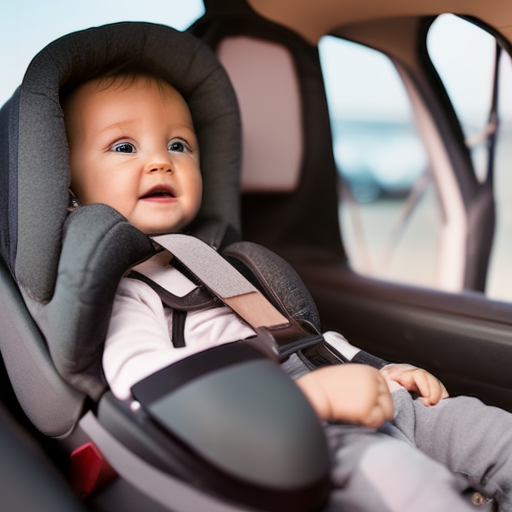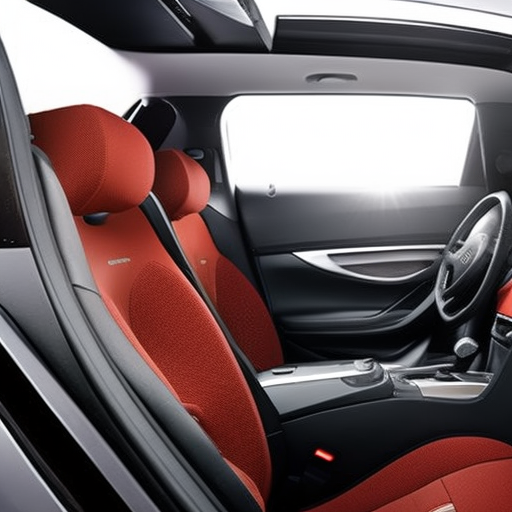"Cherishing Little Steps - A Haven for Baby and Family Journeys"
Rear-Facing Car Seat Benefits
Imagine driving down the road, your precious cargo safely strapped into their car seat. You glance in the rearview mirror and see their innocent face, full of trust and vulnerability. As a parent, your priority is their safety. That’s why choosing a rear-facing car seat is essential.
Not only does it provide enhanced protection, but it also lowers the risk of injury. The proper alignment of their spine and neck reduces the chance of head injury, especially in rear-end collisions. Plus, rear-facing car seats meet all safety standards and have the approval of pediatricians and safety experts.
With a rear-facing car seat, you can have peace of mind knowing that you’ve taken every precaution to keep your child safe on the road.
Key Takeaways
- Rear-facing car seats provide enhanced protection during side impact collisions.
- Rear-facing car seats significantly reduce the risk of serious injury for children.
- Rear-facing car seats offer increased safety in rear-end collisions.
- Rear-facing car seats provide superior protection against side-impact collisions.
Enhanced Protection

To maximize the safety of your child in the car, opt for a rear-facing car seat. Rear-facing car seats provide enhanced protection for your little one, especially during side impact collisions. These car seats are specifically designed to absorb the force of a crash and distribute it evenly across the child’s body, reducing the risk of injury.
When it comes to side impact performance, rear-facing car seats have been proven to be highly effective. They provide a cocoon-like environment for your child, cradling them and minimizing the impact forces that can occur in a side collision. In fact, studies have shown that rear-facing car seats can reduce the risk of serious injury in a side impact crash by more than 60%.
Crash test ratings also play a crucial role in determining the effectiveness of rear-facing car seats. These seats undergo rigorous testing to ensure they meet the highest safety standards. Organizations such as the National Highway Traffic Safety Administration (NHTSA) and the Insurance Institute for Highway Safety (IIHS) conduct extensive crash tests to evaluate the performance of car seats. By choosing a rear-facing car seat with high crash test ratings, you can have peace of mind knowing that your child is well-protected in the event of a collision.
Lower Risk of Injury
By using a rear-facing car seat, you can further decrease the risk of injury for your child. Studies have shown that children are safer when they are seated in a rear-facing position. This is because rear-facing car seats provide enhanced protection by absorbing the impact of a collision and distributing the forces across the child’s body. In fact, the American Academy of Pediatrics recommends that children remain in rear-facing car seats until they reach the maximum height and weight limits specified by the manufacturer.
One of the main reasons why rear-facing car seats reduce the chance of injury is because they provide support for the head, neck, and spine. In the event of a crash, the car seat cradles the child’s body and keeps it in a more secure position. This significantly reduces the risk of whiplash and other injuries that can occur when the head and neck are jolted forward.
To illustrate the benefits of rear-facing car seats, let’s compare the risk of injury in a rear-facing car seat versus a forward-facing car seat:
| Rear-Facing Car Seat | Forward-Facing Car Seat | |
|---|---|---|
| Head Injury Risk | Reduced chance | Increased chance |
| Neck Injury Risk | Reduced chance | Increased chance |
| Spinal Injury Risk | Reduced chance | Increased chance |
| Overall Injury Risk | Reduced chance | Increased chance |
As you can see, using a rear-facing car seat significantly lowers the risk of injury for your child. It is important to prioritize their safety by following the recommendations and guidelines provided by experts.
Proper Spine and Neck Alignment

Ensure proper spine and neck alignment in your child by using a rear-facing car seat. This is crucial for their spinal development and maintaining proper posture.
Here are three reasons why a rear-facing car seat promotes the optimal alignment of your child’s spine and neck:
-
Supports the natural curvature of the spine: Rear-facing car seats are designed to cradle your child’s body, providing support to their developing spine. This helps maintain the natural curvature of their spine, reducing the risk of strain or injury.
-
Reduces stress on the neck: When a child is in a forward-facing car seat, the force of sudden stops or impacts can jerk their head forward, potentially causing whiplash or other neck injuries. A rear-facing car seat absorbs and distributes this force more evenly, minimizing stress on the neck.
-
Limits head movement during a collision: In the event of a crash, a rear-facing car seat keeps your child’s head and neck secure within the seat’s protective shell. This restraint greatly reduces the risk of spinal or neck injuries caused by excessive head movement.
Reduced Risk of Head Injury

Protect your child’s head from injury with a rear-facing car seat. One of the key benefits of using a rear-facing car seat is the reduced risk of head injury. In the event of a collision or sudden stop, a rear-facing car seat provides crucial protection for your child’s head.
When your child is facing the rear, the car seat acts as a cushion, absorbing the impact and distributing the force across a larger area. This helps to minimize the risk of head injury by reducing the amount of force that reaches the head. The design of rear-facing car seats also ensures that the head, neck, and spine are properly aligned, which further enhances the protection.
Studies have shown that rear-facing car seats are highly effective in preventing head injuries in young children. In fact, research has found that children who are in rear-facing car seats have a significantly lower risk of head injury compared to those in forward-facing seats. This is particularly important for infants and toddlers, whose heads are proportionally larger and more vulnerable to injury.
Increased Safety in Rear-End Collisions
When facing a rear-end collision, your child is at an increased level of safety in a rear-facing car seat. The benefits for infants in these situations are significant, thanks to the improved crash test performance of rear-facing car seats. Here’s why:
-
Enhanced Head and Neck Protection: Rear-facing car seats provide superior support to your child’s head and neck during a rear-end collision. The seat’s shell absorbs the impact and distributes the forces across a larger area, reducing the risk of injury.
-
Reduced Whiplash Risk: Rear-end collisions often result in whiplash injuries due to the sudden acceleration and deceleration. Rear-facing car seats mitigate this risk by minimizing the movement of the child’s head and neck, providing a stable and secure position.
-
Lower Risk of Spinal Cord Injury: In rear-facing car seats, the child’s spine is aligned and supported, reducing the chances of spinal cord injuries during rear-end collisions. The seat’s design ensures that the force of impact is distributed evenly, minimizing the strain on the delicate spinal cord.
Enhanced Side-Impact Protection

In rear-facing car seats, your child benefits from enhanced side-impact protection. Side-impact crashes can be particularly dangerous, as they often result in severe injuries to the head and chest. To ensure the highest level of safety, car seat manufacturers conduct extensive side impact crash testing using specialized crash test dummies.
During side impact crash testing, car seats are subjected to simulated crashes that mimic real-life accidents. These tests measure the performance of the car seat in protecting the child’s head, neck, and torso. Crash test dummies, equipped with sensors, are used to collect data on the forces exerted on different body parts during a crash. This data helps manufacturers design car seats with enhanced side-impact protection.
To give you a better understanding of the importance of side-impact protection, let’s take a look at the table below:
| Without Enhanced Side-Impact Protection | With Enhanced Side-Impact Protection | |
|---|---|---|
| Head | Increased risk of head injuries | Reduced risk of head injuries |
| Chest | Higher likelihood of chest trauma | Lower likelihood of chest trauma |
| Neck | Greater chance of neck injuries | Minimized risk of neck injuries |
Support for Fragile Body Parts

With enhanced side-impact protection, rear-facing car seats also provide crucial support for your child’s fragile body parts. Here’s how:
-
Head and Neck Support: Rear-facing car seats are designed to cradle your child’s head and neck, protecting them from sudden jolts or impacts. This is especially important for infants and young children, whose neck muscles are still developing and are more prone to injury.
-
Spinal Alignment: The rear-facing position helps to maintain proper spinal alignment for your child. The seat’s reclined position allows for the natural curvature of your child’s spine, reducing the risk of strain or compression on their delicate spinal cord.
-
Protection for Developing Bones: Babies and young children have softer, more flexible bones that are still growing. Rear-facing car seats provide a supportive cocoon-like environment that helps to protect their fragile bones from potential fractures or injuries in the event of a crash.
Minimized Risk of Ejection
Keep your child securely restrained in a rear-facing car seat to significantly reduce the risk of ejection during a crash. Rear-facing car seats provide numerous benefits, and minimizing the risk of ejection is one of the most crucial ones. Proper installation of the car seat is of utmost importance to ensure its effectiveness.
During a crash, the force exerted on a vehicle can be immense. In such situations, a rear-facing car seat acts as a protective cocoon for your child, keeping them securely in place. The design of these car seats, with their high backs and sturdy harnesses, helps distribute the crash forces over a larger area of the body, reducing the chances of ejection.
The importance of proper installation can’t be overstated. It’s recommended to carefully read the car seat manual and follow the manufacturer’s instructions to ensure correct installation. Incorrect installation can compromise the car seat’s effectiveness and increase the risk of ejection. Many car seat manufacturers also offer assistance with installation, either through instructional videos or in-person appointments with certified technicians.
Longer Use and Extended Rear-Facing Stage
You can extend the use of a rear-facing car seat by transitioning to an extended rear-facing stage. This not only provides additional safety but also offers some longevity benefits.
Here are three reasons why extended use of a rear-facing car seat is beneficial:
-
Enhanced protection: Rear-facing car seats are known for their ability to protect your child’s head, neck, and spine in the event of a collision. By using an extended rear-facing stage, you can continue to provide this crucial protection for a longer period.
-
Reduced risk of injury: Research has shown that rear-facing car seats significantly reduce the risk of serious injury in young children. By extending the use of a rear-facing car seat, you’re giving your child the best chance of staying safe and minimizing the impact of a car accident.
-
Developmental benefits: Rear-facing car seats promote proper alignment of the child’s spine and allow for better weight distribution. This can contribute to the healthy development of their musculoskeletal system.
Compliance With Safety Standards
To ensure the utmost safety, it is crucial to ensure that rear-facing car seats comply with all relevant safety standards. Compliance with regulations and adherence to safety guidelines are essential to protect your child in case of an accident. The government has set specific standards to ensure the quality and effectiveness of car seats, and it is important to choose a seat that meets these requirements.
To help you understand the safety standards, here is a table summarizing some of the key regulations for rear-facing car seats:
| Safety Standard | Description | Importance |
|---|---|---|
| FMVSS 213 | Federal Motor Vehicle Safety Standard 213 sets requirements for child restraint systems, including rear-facing car seats. This standard ensures the seat’s structural integrity, restraint system, and labeling. | Ensures the seat’s overall safety and performance. |
| Side-Impact Testing | Some car seats undergo side-impact testing to evaluate their ability to protect a child’s head, neck, and torso in a side-impact crash. | Provides additional protection in the event of a side-impact collision. |
| Energy Absorption | Car seats with energy-absorbing materials help reduce the force transferred to a child’s body during a crash, minimizing the risk of injury. | Enhances the seat’s ability to protect your child in a collision. |
| Easy Installation | Car seats that are easy to install correctly reduce the risk of improper installation, ensuring maximum safety for your child. | Facilitates proper installation, reducing the chance of errors that compromise effectiveness. |
Peace of Mind for Parents

With a rear-facing car seat, parents can have peace of mind knowing their child is protected during car journeys. Here are three reasons why a rear-facing car seat provides parental reassurance and child comfort:
-
Enhanced Safety: Rear-facing car seats are designed to provide optimal protection for infants and young children. They offer superior protection for your child’s head, neck, and spine in the event of a collision. The rear-facing position reduces the risk of injury by evenly distributing the impact forces across the child’s body.
-
Secure Restraint: Rear-facing car seats feature a five-point harness system that keeps your child securely restrained. This ensures that your little one stays in place and minimizes the risk of ejection during an accident. The snug fit of the harness keeps your child comfortably in position, allowing them to rest or sleep peacefully during car rides.
-
Peaceful Journey: Knowing that your child is safe and comfortable in a rear-facing car seat can give you peace of mind. You can focus on driving without worrying about their well-being. The added reassurance allows you to enjoy the journey, knowing that your child is protected and content.
Recommended by Pediatricians and Safety Experts

Pediatricians and safety experts strongly recommend the use of rear-facing car seats for infants and young children. This expert-recommended safety measure is based on extensive research and analysis of car crash data. Rear-facing car seats provide numerous benefits that contribute to the overall safety and well-being of children during car journeys.
One of the key benefits of rear-facing car seats is the superior protection they offer to a child’s head, neck, and spine. In the event of a sudden stop or collision, the force is distributed across the entire back of the car seat, reducing the risk of injury. This is particularly important for infants and young children, as their necks and spinal cords are still developing and are more vulnerable to injury.
Additionally, rear-facing car seats help to prevent ejection from the vehicle during a crash. The design of these seats, with their sturdy harness systems and energy-absorbing materials, significantly reduces the likelihood of a child being thrown from the car seat.
Moreover, rear-facing car seats provide better protection in the event of a frontal crash, which is the most common type of collision. The seat’s back absorbs the impact and spreads the forces over a larger area, reducing the risk of severe injuries.
Frequently Asked Questions
Are Rear-Facing Car Seats More Expensive Than Forward-Facing Car Seats?
Rear-facing car seats can be more expensive than forward-facing ones, but the extra cost is worth it for the added safety they provide. Rear-facing seats are proven to better protect infants and young children in car accidents.
Can Rear-Facing Car Seats Be Used for Newborns?
You’ll be glad to know that rear-facing car seats can indeed be used for newborns. In fact, it is recommended to keep infants in rear-facing seats until they reach a certain age.
How Long Should a Child Stay in a Rear-Facing Car Seat?
You should keep your child in a rear-facing car seat until they reach the maximum weight or height limit specified by the manufacturer. Transitioning to forward-facing too soon can increase the risk of injury. Extended rear-facing has many benefits, such as better protection for your child’s head, neck, and spine.
Are Rear-Facing Car Seats Suitable for All Types of Vehicles?
Are rear-facing car seats suitable for all types of vehicles? Yes, they are. Rear-facing car seat installation can be done in any vehicle as long as the weight limits are followed. It’s important for your child’s safety.
Are There Any Disadvantages to Using a Rear-Facing Car Seat?
There are a few potential disadvantages to using a rear-facing car seat, such as limited leg room for older children. However, the pros outweigh the cons as rear-facing seats are generally considered safer for all ages.
Conclusion
In conclusion, choosing a rear-facing car seat for your child is like giving them a suit of armor.
It provides enhanced protection, proper alignment for their spine and neck, and reduces the risk of head injury.
It also offers increased safety in rear-end collisions and complies with safety standards.
Pediatricians and safety experts recommend it, giving parents peace of mind.
So, buckle up your little one in a rear-facing seat and let them embark on their journey protected and secure.


